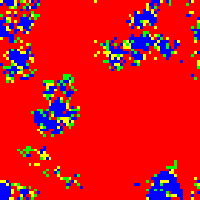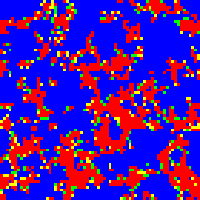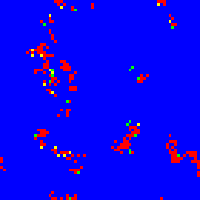
Public goods games:
Structured populations
by Christoph Hauert, Version 2.2, September 2005.
- Location:
- VirtualLabs
- » Public Goods games
- » Structured populations
In contrast to well-mixed populations with interactions among randomly formed groups, cooperators can thrive in structured populations with limited local interactions. The population structure enables cooperators to form clusters and thereby reduces exploitation by defectors. This result is well-known for pairwise interactions in the prisoner's dilemma but also holds for interactions among larger groups. However, for increasing group sizes, persistence of cooperation requires increasing values of the public good, i.e. of the multiplication factor to compensate for the fact that larger groups are more efficiently exploited.
The advantage for cooperators arising from the population structure is limited, however. Whenever conditions become too harsh, i.e. for small multiplication factors r, cooperators vanish just as in well-mixed populations. The success of cooperators is intrinsically linked to the underlying population structure. Moreover, the extinction process of cooperators exhibits a critical phase transition that belongs into the universality class of directed percolation. Essentially the same characteristic dynamics occurs for large r when defectors are driven to extinction.
Collections
All collections provide more detailed information on different aspects of the dynamics of public goods games in structured populations including many preconfigured simulations illustrating and highlighting particular scenarios.
 |
Spatial geometryThe details of the population structure have considerable effects on the equilibrium fractions of cooperators and defectors. Generally, clustering opportunities promotes cooperators whereas stochastic noise favors defectors. These antagonistic effects are considered for different lattice types, i.e. for different number of nearest neighbors, but for constant group sizes. The figure on the left depicts a typical snapshot of public goods interactions in groups of four individuals on square lattices with four nearest neighbors. |
|---|---|
 |
Phase transitionsThe extinction of cooperators at low r as well as the elimination of defectors at high r exhibit critical phase transitions that suggest interesting links to condensed matter physics. Moreover, the diverging fluctuations and correlation lengths of such transitions have interesting consequences for biological systems. |
VirtualLab
The buttons along the bottom of the applet control the execution and the speed of the simulations. Of particular importance are the Param button and the data views pop-up list on top. The former opens a panel that allows to set and change various parameters concerning the game as well as the population structure, while the latter displays the simulation data in different ways. Use the above collections to run simulations illustrating particular scenarios with all parameters preset accordingly.
| Color code: | Cooperators | Defectors |
|---|---|---|
| New cooperator | New defector |
| Payoff code: | Low | High |
|---|
Note: The yellow and green colors are very useful to get an intuition of the activitiy in the system. The shades of grey of the payoff scale are augmented by blueish and reddish shades, which indicate the payoffs for mutual cooperation and defection, respectively.
| Controls | |
| Params | Pop up panel to set various parameters. |
|---|---|
| Views | Pop up list of different data presentations. |
| Reset | Reset simulation |
| Run | Start/resume simulation |
| Next | Next generation |
| Pause | Interrupt simulation |
| Slider | Idle time between updates. On the right your CPU clock determines the update speed while on the left updates are made roughly once per second. |
| Mouse | Mouse clicks on the graphics panels generally start, resume or stop the simulations. |
| Data views | |
| Structure - Strategy | Snapshot of the spatial arrangement of strategies. Mouse clicks cyclically change the strategy of the respective site for the preparation of custom initial configurations. |
|---|---|
| Structure - Fitness | Snapshot of the spatial distribution of payoffs. |
| Mean frequency | Time evolution of the strategy frequencies. |
| Mean Fitness | Time evolution of the mean payoff of each strategy together with the average population payoff. |
| Histogram - Fitness | Histogram of payoffs for each strategy. |
Game parameters
The list below describes only the few parameters related to the voluntary public goods game. Follow the link for a complete list and descriptions of all other parameters e.g. referring to update mechanisms of players and the population.
- Interest:
- multiplication factor r of public good.
- Cost:
- cost of cooperation c (investment into common pool).
- Init Coop, init defect:
- initial fractions of cooperators, defectors and loners. If they do not add up to 100%, the values will be scaled accordingly. Setting the fraction of cooperators to 100% and the others to zero, then the lattice is initialized with a symmetrical configuration suitable for observing evolutionary kaleidoscopes.